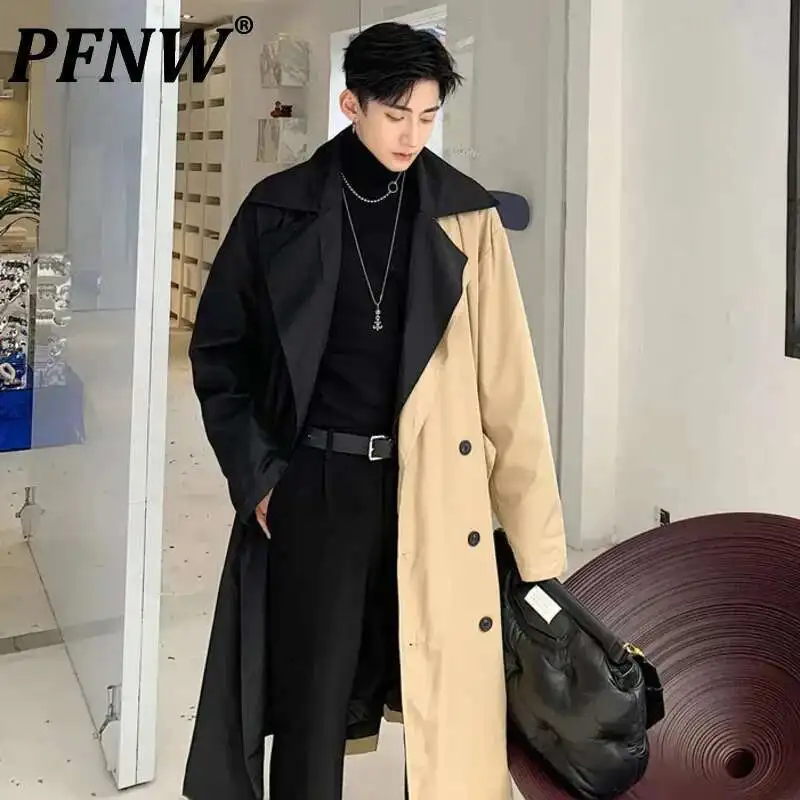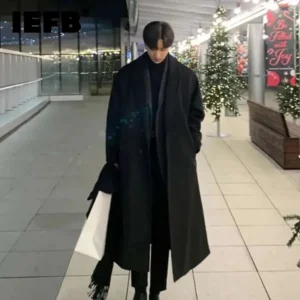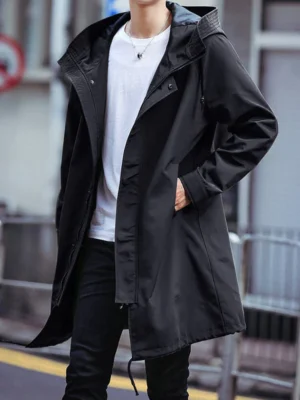Understanding the Double-Breasted Coat: Timeless Statement Piece
The double-breasted coat stands as one of menswear’s most distinguished and commanding garments. Unlike its single-breasted counterpart, this coat features overlapping front panels with two parallel columns of buttons—typically featuring between four and six buttons, with only some functional. This distinctive design creates a wrap-around effect that naturally adds structure and formality to the wearer’s silhouette.
What truly sets a double-breasted coat apart is its bold, authoritative presence. The wider lapels and overlapping front create a V-shaped torso that enhances most body types while providing superior protection against harsh weather elements. This practical feature reveals the coat’s naval origins, where officers needed protection from bitter winds at sea.
The journey of the double-breasted coat from military uniform to civilian wardrobe represents one of fashion’s most successful transitions. While today’s double-breasted vs single-breasted options offer different aesthetic choices, it’s important to distinguish between:
- Double-breasted coats: Longer outerwear garments ending at or below the knee
- Double-breasted blazers/jackets: Shorter pieces typically ending at the hip
The construction of quality double-breasted overcoats involves several distinctive elements:
- Wider, peaked lapels that create a powerful shoulder line
- Overlapping front panels that provide extra warmth
- A 6×2 or 4×2 button configuration (total buttons vs. functional buttons)
- A defined waist that creates elegant drape
Understanding these elements is essential before exploring the ultimate guide to men’s double-breasted coats in depth, as they form the foundation for appropriate styling decisions.
Decoding Double-Breasted Coat Formality: Style Elements that Matter
Double-breasted coats inherently convey a more formal impression than their single-breasted counterparts. This elevated formality stems from their structured silhouette, commanding presence, and historical association with military officers and aristocracy. However, their versatility extends far beyond purely formal settings.
Several key elements determine the formality level of a double-breasted coat:
- Material quality: Premium fabrics like cashmere and fine wool signify greater formality, while cotton blends and textured materials appear more casual
- Color choice: Dark, solid colors (navy, black, charcoal) read as most formal, while camel, light grays, and patterns project a more relaxed vibe
- Construction details: Structured shoulders, hand-stitched buttonholes, and high-quality linings elevate formality
- Cut and silhouette: Sharper, more defined lines create formality while relaxed fits trend casual
Despite their reputation for formality, formal double-breasted coats can be successfully styled for various occasions. The key lies in balancing the coat’s inherent structure with complementary pieces that either enhance or counterbalance its formality.
Modern double-breasted coats, particularly those in the wool overcoat category, offer exceptional versatility when paired thoughtfully. Their ability to transition between dress codes makes them an investment piece rather than a one-occasion garment.
Best Occasions for Your Double-Breasted Coat
Formal & Ceremonial Events: Making a Distinguished Impression
The double-breasted coat reaches its full potential at formal events, where its commanding presence and refined silhouette perfectly complement ceremonial attire. These occasions allow the coat to showcase its aristocratic heritage and timeless elegance.
Ideal formal occasions for a double-breasted coat include:
- Black-tie galas and evening receptions
- Formal weddings and religious ceremonies
- High-profile business functions
- Theater premieres and cultural events
- Diplomatic functions and state occasions
For these events, styling should emphasize refinement and traditional elegance:
- Select a dark-colored coat (black or midnight navy) in premium wool or cashmere
- Pair with formal attire such as a tuxedo, dark suit, or formal evening wear
- Choose formal accessories: leather gloves, silk scarf, polished oxfords
- Keep the silhouette clean and structured, with minimal bulky layers underneath
The right dress coat becomes a statement of sophistication at formal events, where its structured silhouette frames the wearer with distinction. When properly fitted and styled, it conveys an unmistakable air of refinement that perfectly complements the ceremonial atmosphere.
Business & Professional Settings: Conveying Confidence & Authority
In professional environments, the double-breasted coat projects authority, confidence, and attention to detail—qualities highly valued in business settings. Its structured silhouette creates an impression of competence and classical taste.
Appropriate business occasions include:
- Important client meetings and presentations
- Executive interviews and board meetings
- Professional conferences and industry events
- Business dinners and networking functions
- Daily office wear in traditional industries (finance, law, consulting)
For business styling, balance formality with practical professionalism:
- Choose navy, charcoal, or camel coats in wool or cashmere blends
- Pair with business suits, dress shirts, and coordinating ties
- Select refined leather accessories: portfolio, gloves, cap-toe shoes
- Maintain a clean silhouette that conveys efficiency and attention to detail
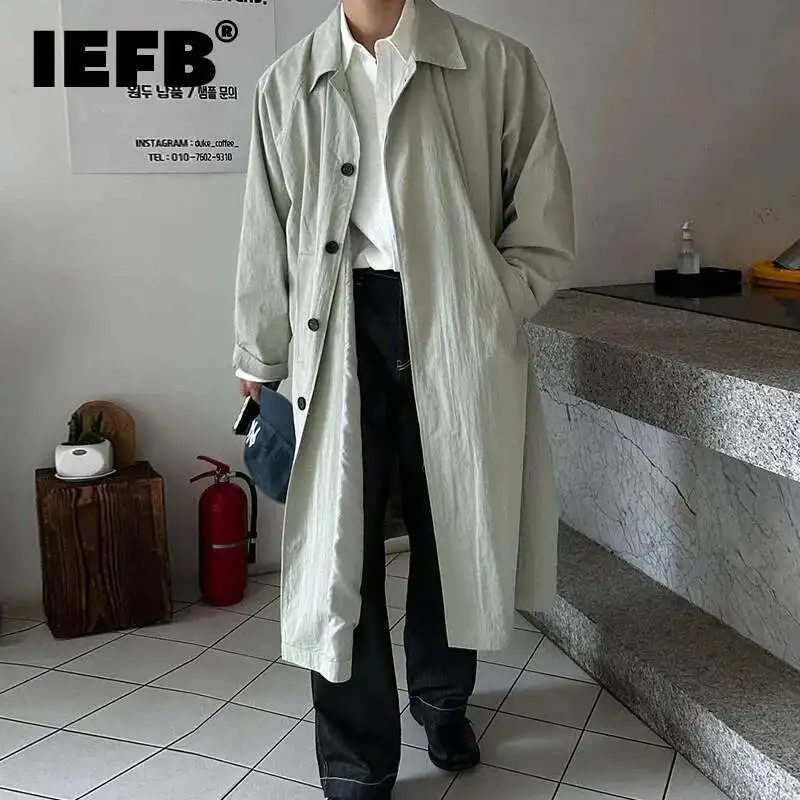
Understanding the nuances of men’s dress coats helps professionals make appropriate choices that enhance their business image rather than distract from it. The right double-breasted coat becomes a power piece that frames your professional presence with distinction.
Smart Casual Engagements: Sophisticated Yet Relaxed
Smart casual settings offer an ideal middle ground for showcasing the versatility of a double-breasted coat. In these environments, the coat’s inherent formality adds polish to otherwise relaxed outfits, creating a balanced and considered appearance.
Perfect smart casual occasions include:
- Restaurant dinners and casual evening events
- Weekend gatherings with friends or family
- Cultural events and museum visits
- Casual Friday workplaces
- Daytime dates and social outings
For smart casual styling, create pleasant tension between formal and relaxed elements:
- Select coats in versatile colors like camel, medium gray, or navy
- Pair with chinos or dark denim and quality knitwear or casual button-downs
- Choose refined casual footwear like Chelsea boots, loafers, or clean sneakers
- Add personality with textured accessories like knit scarves or leather gloves
A black overcoat in a slightly relaxed cut provides exceptional versatility for smart casual wear. The key to success lies in balancing the coat’s formality with more relaxed accompanying pieces while maintaining an overall sense of intention and coordination.
Elevated Everyday & Casual Wear: Adding Distinction to Daily Style
Contrary to conventional thinking, the double-breasted coat can successfully transition into everyday wear, adding sophistication to casual outfits without appearing overdressed. This approach works particularly well in urban environments where style consciousness is the norm.
Suitable casual occasions include:
- Daily commuting and city exploration
- Weekend coffee outings and casual shopping
- Informal social gatherings
- Casual dining and entertainment
- Running errands with style
For casual styling, deliberately contrast the coat’s formality with relaxed elements:
- Choose coats with relaxed shoulders and less structured silhouettes
- Pair with jeans, casual sweaters, t-shirts, or casual button-downs
- Select casual footwear like desert boots, clean sneakers, or casual loafers
- Add relaxed accessories like casual beanies, colorful scarves, or canvas bags
Understanding how to style a double-breasted coat for casual settings involves embracing controlled contrast—allowing the coat’s inherent formality to elevate casual pieces while the relaxed elements make the coat feel more approachable and less stuffy.
Mastering the Style: How to Wear Your Double-Breasted Coat
The Perfect Fit: Essential for a Sharp Look
The single most important factor in successfully wearing a double-breasted coat is achieving the perfect fit. Unlike more forgiving styles, a double-breasted coat’s overlapping front panels and structured silhouette demand precise tailoring to look their best.
Key fit elements to focus on include:
- Shoulders: The seam should sit precisely at your shoulder’s edge—neither hanging off nor pinching inward
- Length: Traditional double-breasted coats should cover your seat, typically ending just above the knee
- Sleeves: Should end at your wrist bone, allowing about ¼ inch of shirt cuff to show
- Chest and waist: When buttoned, the coat should close smoothly without pulling or creating an “X” across the chest
- Lapels: Should lie flat against the chest without gaping or buckling
Common fit issues to avoid:
- Shoulders too wide, creating a droopy appearance
- Too tight across the chest when buttoned, causing fabric to pull
- Sleeves too long, overwhelming the hands
- Overall length too short, creating unbalanced proportions
Consulting an expert guide to double-breasted coat fit can help address specific body types and proportions. Remember that alterations are almost always necessary, even with high-quality ready-to-wear coats, to achieve that perfect personal fit.

Seasonal Fabric Choices: Adapting to Weather with Style
The fabric of your double-breasted coat significantly impacts both its functionality and stylistic versatility across seasons. Understanding the right materials for different weather conditions ensures your coat performs as beautifully as it looks.
For winter and cold weather:
– Heavy wool (20-32 oz): Maximum warmth and structure, ideal for harsh winters
– Cashmere: Luxurious warmth with exceptional softness, perfect for formal occasions
– Wool-cashmere blends: Practical luxury that balances warmth, durability, and softness
– Tweed: Textured, rustic option with excellent insulation for countryside settings
For transitional seasons:
– Medium-weight wool (14-20 oz): Versatile option for fall and mild winter days
– Gabardine: Tightly woven, water-resistant fabric ideal for rainy conditions
– Wool-silk blends: Lightweight elegance for formal spring occasions
– Cotton twill: Casual option for spring that offers light protection
Color considerations should also follow seasonal patterns:
– Fall/Winter: Darker colors like navy, charcoal, black, and deep camel
– Spring/Fall: Medium tones like tan, light gray, and sage green
– Year-round options: Navy and camel work across seasons with appropriate weight
Selecting the right fabric weight ensures your coat provides appropriate warmth without unnecessary bulk, maintaining the clean lines essential to double-breasted styling.
Layering Like a Pro: Creating Depth and Dimension
Mastering layering with a double-breasted coat requires balancing warmth and comfort with maintaining the coat’s clean lines. Unlike more forgiving outerwear, double-breasted coats demand thoughtful consideration of what goes underneath.
For formal layering:
– Fine merino or cashmere sweaters over dress shirts
– Lightweight suit jackets or blazers (ensuring shoulders aren’t too bulky)
– Thin formal scarves tucked inside the coat
– Minimal bulk around the chest to maintain clean closure
For smart casual layering:
– Lightweight knitwear like merino crewnecks or thin turtlenecks
– Casual button-downs without bulky pockets or details
– Thin quilted vests for added warmth without bulk
– Scarves that can be worn inside or outside the coat depending on temperature
The advantages of double-breasted coats include their naturally warmer design due to overlapping panels, which often reduces the need for extremely thick layers underneath. This benefit helps maintain the coat’s elegant silhouette even in cold conditions.
Key layering principles:
– Each layer should be progressively thinner moving inward
– Avoid bulky items that create lumps or distort the coat’s clean lines
– Consider the neckline of inner layers in relation to the coat’s lapels
– Maintain color harmony between visible layers
Complete Your Look: Trousers and Footwear Combinations
Creating harmony between your double-breasted coat and what you wear below the waist ensures a cohesive, well-planned appearance. The right trousers and footwear complete your look while reinforcing the appropriate formality level.
Formal trouser options:
– Dress suit trousers in matching or complementary dark tones
– Flannel dress pants with crisp creases
– Formal wool trousers with minimal break at the shoe
– Always with proper tailoring and clean lines
Smart casual trouser choices:
– Well-fitted chinos in neutral colors
– Wool-blend casual trousers
– Dark, clean denim with minimal distressing
– Corduroy or moleskin pants in colder months
Footwear pairings should follow the formality scale:
– Formal: Polished oxfords, whole-cut shoes, or formal derby shoes
– Business: Cap-toe oxfords, brogues, or Chelsea boots
– Smart casual: Loafers, Chelsea boots, desert boots, or clean leather sneakers
– Casual: Quality sneakers, casual boots, or refined moccasins
Color coordination principles:
– Match leather shoes to leather accessories (belt, gloves)
– Ensure trouser color creates pleasing contrast with coat
– Consider the full color story from head to toe
– Darker colors generally read as more formal
Mens Cashmere Overcoat, Mens Hooded Winter Coat, Mens Wool Blend Coat
Price range: $128.72 through $139.68 Select options This product has multiple variants. The options may be chosen on the product pageMens Black Overcoat, Mens Black Wool Coat, Mens Wool Overcoat
$339.18 Select options This product has multiple variants. The options may be chosen on the product pageMens Grey Overcoat, Mens Wool Blend Coat, Mens Wool Overcoat
$201.28 Select options This product has multiple variants. The options may be chosen on the product pageMens Herringbone Coat, Mens Long Overcoat, Mens Wool Overcoat
Price range: $197.16 through $203.69 Select options This product has multiple variants. The options may be chosen on the product pageMens Black Overcoat, Mens Long Overcoat
Price range: $100.12 through $173.24 Select options This product has multiple variants. The options may be chosen on the product pageMens Dress Coat, Mens Long Overcoat
$76.76 Select options This product has multiple variants. The options may be chosen on the product page
Perfecting the Details: Essential Styling Elements
The Art of Accessorizing: Elevate Your Double-Breasted Look
Accessories provide the perfect finishing touches to a double-breasted coat, enhancing its inherent elegance while expressing personal style. The right accessories complement the coat’s formality level while adding functional benefits.
Scarf options and styling:
– Formal: Silk or cashmere in solid colors or subtle patterns
– Business: Fine wool or cashmere-blend in complementary colors
– Casual: Textured knits or patterned wool designs
– Styling methods: Parisian knot for formal looks, loose drape for casual settings
Glove considerations:
– Formal: Fine leather in black or brown with minimal detailing
– Business: Leather or leather-cashmere combination in coordinating colors
– Casual: Wool, suede, or textured leather in complementary tones
– Fit: Should be snug but comfortable with adequate finger mobility
Hat pairings:
– Formal: Felt fedora or homburg in matching or complementary dark tones
– Business: Classic felt fedora or structured wool cap
– Casual: Relaxed wool beanie, casual fedora, or textured flat cap
– Always consider proportion—wider coat lapels generally balance well with wider hat brims
The classic double-breasted coat guide emphasizes that accessories should enhance rather than compete with the coat’s strong presence. When in doubt, select fewer, higher-quality accessories rather than overwhelming the look with too many elements.
Buttoning Rules: Maintaining the Proper Silhouette
Understanding the traditional buttoning conventions for double-breasted coats ensures you achieve the proper silhouette and maintain the garment’s intended drape. Unlike single-breasted styles, these coats follow specific rules that enhance their distinctive appearance.
Basic buttoning guidelines:
- The anchor button: The top outside button (known as the “jigger” or “anchor”) should always be fastened first to establish proper alignment
- Functional buttons: Typically only 1-2 buttons are meant to be fastened (usually the middle or lower buttons)
- Standing vs. sitting: Always unbutton your coat when sitting to prevent unsightly pulling and potential damage to the garment
- Full closure: Unlike single-breasted coats, double-breasted styles should remain buttoned when worn (except when sitting) to maintain their clean lines
Common button configurations:
- 6×2: Six buttons with two functional (most traditional and formal)
- 4×2: Four buttons with two functional (slightly more modern look)
- 6×1: Six buttons with one functional (contemporary interpretation)
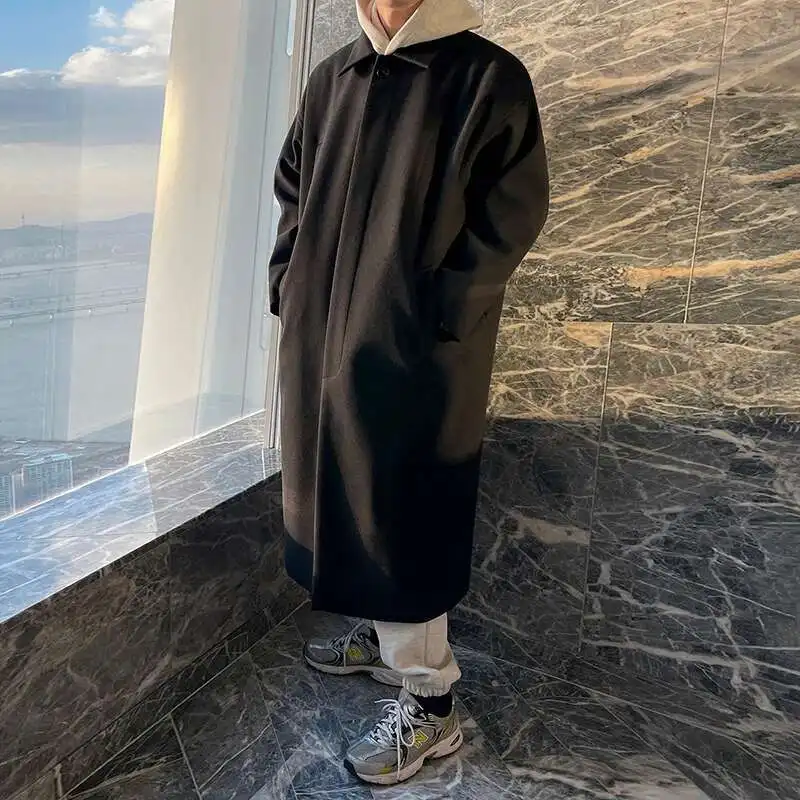
Understanding the nuances of double-breasted coat buttoning helps maintain the garment’s elegant lines. Remember that proper buttoning creates the distinctive wrapped appearance that defines the double-breasted style, framing the chest and creating a flattering V-shaped silhouette.
Beyond the Basics: Specialized Considerations
Body Type Considerations: Finding Your Perfect Double-Breasted Style
While double-breasted coats have historically been associated with certain body types, modern tailoring allows them to flatter virtually any physique when properly selected and fitted. Understanding your body’s proportions helps identify the most flattering options.
For shorter or stockier builds:
– Choose styles with a higher button stance to elongate the torso
– Opt for 4×2 button configurations rather than 6×2 for less visual clutter
– Select narrower lapels to create proportion
– Ensure proper length (covering the seat without extending too far)
– Consider a slightly tapered waist for definition
For taller or slimmer frames:
– Wider lapels add substance to narrow shoulders
– 6×2 button configurations work well with longer torsos
– Fuller cuts create dimension on very slim builds
– Slightly longer lengths flatter tall frames
– Consider horizontal patterns to add visual width
Universal principles:
– Proper shoulder fit is non-negotiable for all body types
– Appropriate sleeve length maintains proportion
– Waist suppression should be proportional to your natural waist
– Overall length should harmonize with your height
With thoughtful selection and proper tailoring, double-breasted coats can be among the most flattering garments for nearly any physique, often enhancing the wearer’s natural proportions.
Investment Care: Maintaining Your Double-Breasted Coat
A quality double-breasted coat represents a significant investment that, with proper care, can provide decades of service while maintaining its distinguished appearance. Implementing consistent maintenance routines preserves both the coat’s aesthetic appeal and functional performance.
Essential storage practices:
– Use broad, wooden hangers that support the shoulders properly
– Allow adequate space between garments to prevent crushing
– Cover with breathable garment bags during off-season storage
– Never store in plastic, which can trap moisture and damage fibers
Cleaning guidelines:
– Brush regularly with a quality clothes brush to remove surface dirt
– Spot clean minor stains immediately with appropriate techniques
– Dry clean only when necessary (typically 1-2 times per season)
– Always follow material-specific care instructions
Maintenance routines:
– Air out after wearing before returning to the closet
– Address minor repairs immediately before they worsen
– Steam rather than iron to remove wrinkles
– Use cedar products to deter moths in natural fiber coats
With proper care, the definitive styles of double-breasted overcoats maintain their impressive appearance for years, developing character while retaining their distinctive silhouette. Remember that quality garments improve with age when properly maintained.
FAQ About Double-Breasted Coats
Are double-breasted coats still in style?
Double-breasted coats have transcended trendy status to become true classics. While their popularity may fluctuate slightly year to year, they remain a permanent fixture in refined menswear. Their distinctive silhouette offers timeless elegance that continues to appear on runways and in stylish wardrobes worldwide.
What’s the difference between a double-breasted peacoat and overcoat?
Double-breasted peacoats are shorter (typically hip-length), feature broader lapels, and historically were made from navy wool with anchor buttons. Overcoats are longer (knee-length or below), come in various fabrics and colors, and are designed to be worn over suits or formal attire.
Can I wear a belt with a double-breasted coat?
Traditional double-breasted coats are designed without belts to maintain their clean lines. However, some modern interpretations include belts for a more casual, relaxed appearance. When present, the belt should be tied rather than buckled for a sophisticated look.
How long should my double-breasted coat be?
Traditional double-breasted overcoats should cover your suit jacket and end just above or at the knee. More contemporary interpretations may be slightly shorter (mid-thigh), while formal options might extend below the knee. The key is proportional balance with your height and overall build.
Can double-breasted coats work for very casual settings?
Yes, with thoughtful styling. Choose less structured versions in more casual fabrics, pair with relaxed items like jeans and sweaters, and consider leaving the coat unbuttoned for a more relaxed appearance. The contrast between the coat’s formality and casual elements creates an interesting style statement.
Can Double-Breasted Coats Work in Casual Settings?
The versatility of double-breasted coats extends well beyond formal occasions. While their structured silhouette naturally conveys elegance, contemporary styling approaches have successfully integrated these classic pieces into casual wardrobes.
The key to casual double-breasted coat styling lies in deliberate contrast. Pairing the coat’s inherent formality with relaxed elements creates a balanced look that feels intentional rather than mismatched. For example, a navy double-breasted coat worn over a simple white t-shirt, dark jeans, and clean sneakers creates a sophisticated casual look that works perfectly for weekend outings.
Modern interpretations also feature more relaxed construction—softer shoulders, less structured fabrics, and more comfortable fits—that naturally adapt to casual settings. These design evolutions maintain the distinctive double-breasted silhouette while reducing its traditional stiffness, creating pieces that transition seamlessly between different dress codes.

